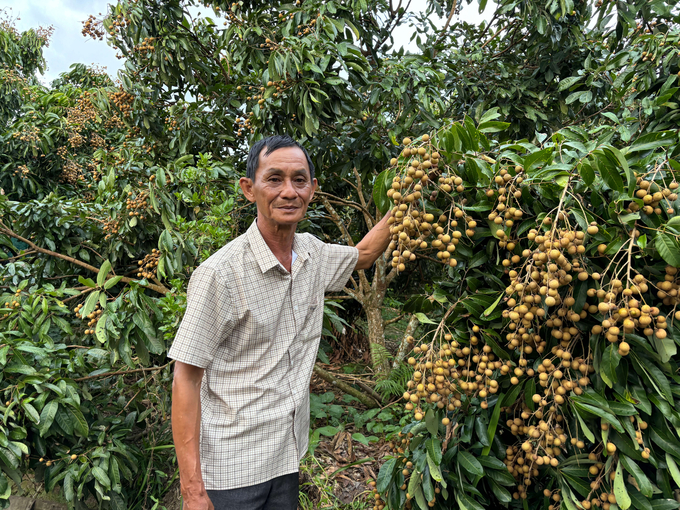November 28, 2025 | 05:35 GMT +7
November 28, 2025 | 05:35 GMT +7
Hotline: 0913.378.918
November 28, 2025 | 05:35 GMT +7
Hotline: 0913.378.918
After six years since its establishment, Nhon Nghia Longan Cooperative (Nhon Phu Hamlet, Nhon Nghia Commune, Phong Dien District, Can Tho City) has affirmed its product quality both domestically and internationally, enabling its members to achieve higher incomes.
The cooperative currently consists of 29 members cultivating a total of 22.5 hectares of longans, yielding an average of 20 tons per hectare for an annual output of 540 tons. With stable prices ranging from 18,000 to 20,000 VND per kilogram, the cooperative’s yearly revenue is estimated at over 10 billion VND.
According to Pham Van Lo, Director of Nhon Nghia Longan Cooperative, local households previously cultivated longans on small plots of land, selling limited amounts of their low-quality harvest to traders, resulting in fluctuating prices. Following the cooperative’s formation and adoption of VietGAP standards for cultivation practices, its product value has increased and quality control has improved significantly.

Pham Van Lo in his Ido longan farm. Photo: Ho Thi Thao.
The cooperative primarily cultivates Ido longan, a low-maintenance plant that is highly resistant to pests and features a higher level of productivity compared to other varieties.
Although Ido longan only produces fruit once per year, farmers have learned to induce flowering and fruiting on demand, allowing them to control the timing of harvests. This innovation enables the cooperative to provide a stable year-round supply to traders and export companies.
The peak harvest season for longans falls between September and December every year. In addition to sales to traders, the cooperative capitalizes on its local strengths by organizing farm visits for tourists, who can enjoy fresh fruit on-site. In 2024, the cooperative has also established connections with exporters to supply longans to the U.S. market.
With the aim of maintaining productivity and product quality, Director Lo has collaborated with the district's Agricultural Extension Office to conduct various training sessions over the years. These programs allow participants to share scientific and technical knowledge with cooperative members with the goal of cultivating VietGAP-compliant longans.
Additionally, the cooperative offers regular short-term training sessions, providing farmers with knowledge on fruit tree diseases to enhance pest control and disease management efforts.
This cooperative model has encouraged local households to coordinate and produce crops with a safety-first approach, focusing on reducing chemical fertilizer use and transitioning toward organic practices. Furthermore, this approach has helped reduce production costs and increase profits over time.
Translated by Nguyen Hai Long
/2025/11/27/3830-1-152901_403.jpg)
(VAN) Dong Nai is developing its key crop areas, expanding planting area codes, and applying high technology to increase the value of agricultural products, aiming at a green and sustainable agriculture.

(VAN) Tay Ninh’s livestock sector is undergoing a major transformation, applying high-tech, closed-loop circular models to build sustainable value chains.
/2025/11/26/3627-4-082628_818.jpg)
(VAN) From a small café on the red basalt highlands, Le Van Hoang started a business with clean coffee, building Enjoi Coffee into a symbol of organic agriculture in the Lam Dong plateau.
/2025/11/25/0045-1-135246_13.jpg)
(VAN) Ca Mau is researching a model of sea-encroaching embankments combined with viaducts and logistics service zones, aiming both to prevent erosion and create land funds for marine economic development.

(VAN) The information was shared at the seminar 'Urban Agriculture - Solutions for Developing Green Spaces,' organized by the Kinh te & Do thi Newspaper and the Biotechnology Center of Ho Chi Minh City.
/2025/11/19/4141-2-132831_216.jpg)
(VAN) One of Japfa's outstanding solutions is implementing digital transformation and artificial intelligence (AI) to optimize operations, enhance productivity, and advance sustainable development.
/2025/11/19/4847-1-093540_448.jpg)
(VAN) The Gia Lai Provincial People’s Committee had a working session with the delegation of the U.S. Department of Agriculture, the State of Idaho, and representatives of the State's leading enterprises.